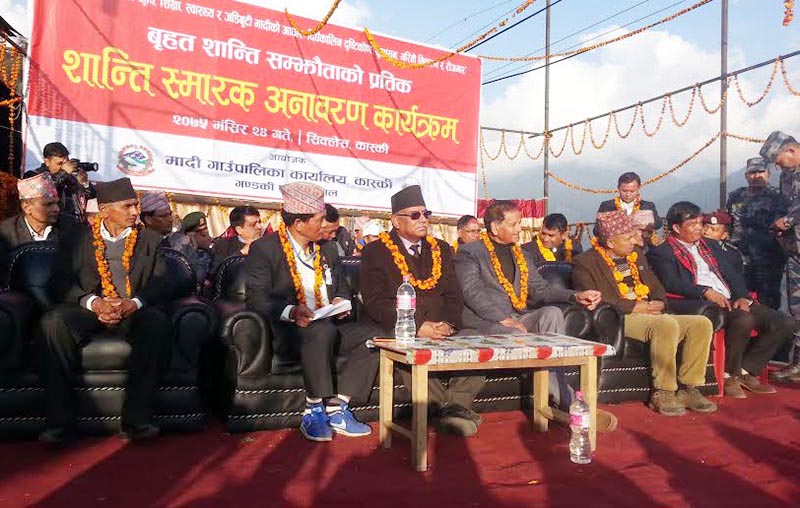Dahal warns of counter-revolution
Sikles, December 10
Nepal Communist Party (NCP) Co-chairperson Pushpa Kamal Dahal has pointed out the threat of anti-revolution facing the country.
Inaugurating a peace monument in Sikles, Kaski, today, the NCP co-chair cited the common trend wherein every great revolution is followed by a counter-revolution. “There is threat of a counter-revolution. It’s not me trying to scare you with this prediction, but indications have been shown by extremist sentiments in the hills and increased activities of various elements seeking to disintegrate the country in the plains these days,” Dahal told the audience.
Further, dwelling on the significance of Sikles in terms of social, culture and tourism aspects, Dahal identified the village as the starting point of the peace process and also remembered the role of late prime minister Girija Prasad Koirala and NC leader Krishna Sitaula in initiating the peace process. Located at an altitude of 2,000 metres in Madi Rural Municipality, Sikles village is known as the starting point of the peace process in Nepal.
After ten years’ armed struggle, the then CPN-Maoist leadership became public for the first time in Sikles.
Then Maoist leaders Pushpa Kamal Dahal and Baburam Bhattarai had left for Baluwatar in Kathmandu to hold talks with the then prime minister Girija Prasad Koirala on 16 June 2006 from Sikles. Then Home Minister Krishna Prasad Sitaula had come to Sikles to escort Dahal and Bhattarai. Sitaula was also present at the programme today.
At the unveiling of the monument, NC leader Sitaula expressed dissatisfaction with the performance of the incumbent government. “I have not seen anything significant happening in this one year,” he said, adding that the government must work as per people’s expectations and Nepali Congress was ready to help the government as a force in opposition.
According to Madi Rural Municipality Chair Bed Bahadur Gurung, the rural municipality invested Rs 10 million to construct the monument as a token of the peace process. Locals had contributed 10 per cent to the construction cost.
Gandak Province lawmaker Man Bahadur Gurung said they had consulted Dahal regarding construction of the peace monument at Sikles.
Sculptor Narad Hartamchhali Kalang had carved a big stone into a statue. From a distance, the statue gives the impression of a mediator sitting pensively. The statue also depicts the symbol of peace — a dove.
Three parts of the monument symbolise three forces: status quoists, transitional forces and revolutionary forces, according to Kalang. The three parts also denote past, present and future.
On top of the monument, an oil lamp was lit and yellow, red and blue colours were lit. ‘These colours symbolize tears, blood and revolution,” said Kalang.
Kalang said it took more than three months for the concept of the monument of the peace process to materialise. Kalang himself had constructed martyrs’ and disappeared people’s monuments on the premises of Parisdanda, Kathmandu, headquarters of the then CPN-Maoist Party.
Earlier, Dahal had laid the foundation stone of a motorable bridge over Bijayapur Khola that connects Madi Rural Municipality with Pokhara Metropolitan City.
Laying the foundation stone of the bridge, Dahal said he would do the needful to construct the bridge that leads to the tourist destination Sikles. “The onus has fallen on my shoulders to construct the bridge that leads to Sikles,” Dahal added. The bridge is estimated to cost Rs 16.5 million.






